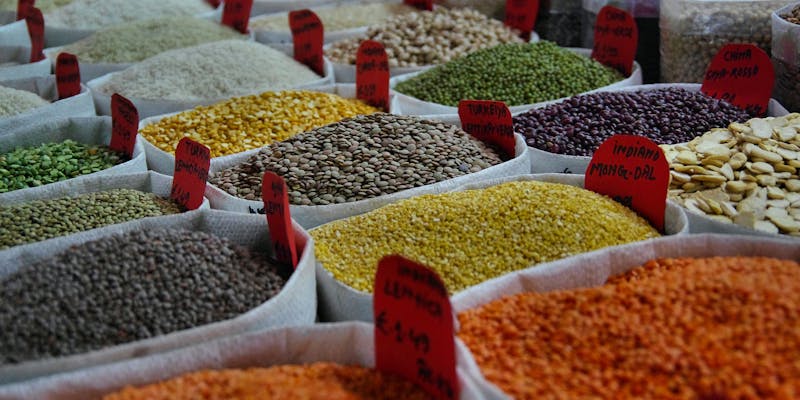Dry Bulk Commodity: Definition, Examples, Index, Vs. Container
Nov 19, 2024 By Pamela Andrew
Dry bulk commodities are very important to the world's economy, but most people probably do not understand their importance. At its most fundamental, dry bulk commodities describe raw materials shipped in large quantities without packaging. It encompasses a wide variety of goods, such as grains, metals, and minerals, which are often considered commodities of fundamental significance to a number of industries.

These goods normally find their way through specialized bulk carriers: those ships that are constructed specifically to make transportation of large volumes of loose material very efficient. While the container ship carries cargo in standardized containers, the bulk carrier has gigantic holds for taking dry bulk commodities; their loading and unloading process is thus simple.
Understanding Dry Bulk Commodities
The physical properties of dry bulk commodities further distinguish shipping processes. These materials are mostly granular or powdery. This characteristic allows them to flow easily. Such a strange characteristic contributes to the facilitation of moving bulk quantities without the use of containers, which would be time-consuming and expensive.
Such transportation is efficient and reduces packaging waste that may damage the environment. This is why dry bulk commodities are the backbones of many industries, from agriculture, whose critical pre-requisites to produce foodstuffs comprise grains such as wheat and corn, to the construction companies producing roads and buildings, a large portion of which has to be extracted as iron ore and cement.
The prices and market dynamics of dry bulk commodities also reflect their transport efficiency. Shipping costs of these commodities are often measured using indices like the Baltic Dry Index (BDI), which measures the rates of shipping commodities in bulk carriers. Divergence in BDI indicates a change in the supply and demand curve of these commodities, which may directly impact their prices in global markets.
As industries expand and diversify, it is the dry bulk commodities that take precedence. They provide indications of the overall performance of the local and global economies since they form the indirect contribution of this sector. Understanding the dynamics of this sector is crucial in terms of understanding broader economic movements and interrelations between global trade patterns.
Examples of Dry Bulk Commodities
Dry bulk commodities are a broad group of very diversified materials. Some of the common examples include grains: wheat, corn, and rice; all these commodities are inevitable for food production. Other agricultural products are soybeans and barley. They are part of the critical composition of the food supply chain and are always traded in international markets.

Besides being agricultural products, dry bulk commodities hold a substantial amount of industrial materials. Iron ore, for instance, is a raw material that supplies the manufacturing of steel and is thus a very important commodity within construction and manufacturing industries. The same can be said about coal, which is another very important dry bulk commodity whose main applications have been fuel and power generation, and further uses comprise steel manufacture.
Other examples are minerals like bauxite, the major source of aluminum ore, and phosphate rock, which is utilized to constitute fertilizers. These commodities hold extremely significant applications within the industry, and related market uncertainty from availability and price movements creates ripples globally. Examples such as these help us understand why dry bulk commodities are so important for everyday life and global business.
Dry Bulk Index
Most players in the industry monitor the market conditions of dry bulk commodities in terms of indices. The most notable among these is the Baltic Dry Index, which measures the shipping rates of bulk carriers worldwide for dry bulk cargo. This is a critical indicator of global trade activity since it reflects the demand for dry bulk shipping capacity.
The calculation of the BDI is taken from shipping a diversity of dry bulk commodities such as iron ore, coal, and grains. This index is formed on different types of vessels such as Capesize, Panamax, and Supramax that are built to transport bulk goods of different sizes and quantities. Fluctuations in BDI often mirror changes in shifts in the global balance of demand and supply dynamics. Therefore, it can be very useful for traders and analysts who try to measure what market conditions will be like in the near future.
How Dry Bulk Commodities Compare to Container Shipping?
Although both dry bulk commodities and container shipping are essential elements of international trade, they represent two quite different conceptions of cargo movement. The movement of cargo in the case of container shipping is done in standard containers that can be anything from electronics to clothing. That is also a highly flexible operation due to the efficiency of the loading and offloading processes at ports.
However, dry bulk shipping is solely based on loose goods requiring specialized vessels accommodated for their specific characteristics. Such vessels present large holds to accommodate sufficient amounts of dry bulk commodities that can transport more than what a container ship may carry.
Another key distinction is through the categories of commodities being hauled. Container shipping can very easily be adapted towards different types of products-from perishable goods, manufactured items and raw materials in different patterns. Dry bulk shipping is, however, tied down to particular categories of raw materials; these are primarily goods that may be transported in bulk without packaging.

A second difference lies in the pricing structures. The rates of container shipping tend to range across different orders of magnitude because their rates depend on the types of cargoes and routes as well as which market demand is realized. Dry bulk shipping rates, for example, may be susceptible to the Baltic Dry Index and are significantly sensitive to dry bulk market supply and demand dynamics.
Conclusion
To understand the importance of dry bulk commodities, you have to understand their place in global trade. These raw materials are mostly agricultural-based but also construction-based, playing a huge part in different industries. Their proper transportation becomes an important factor in economic stability. From grains to metals, examples such as these are often very important in the market dynamics- the price, demand, and supply are all part of dry bulk commodities.








